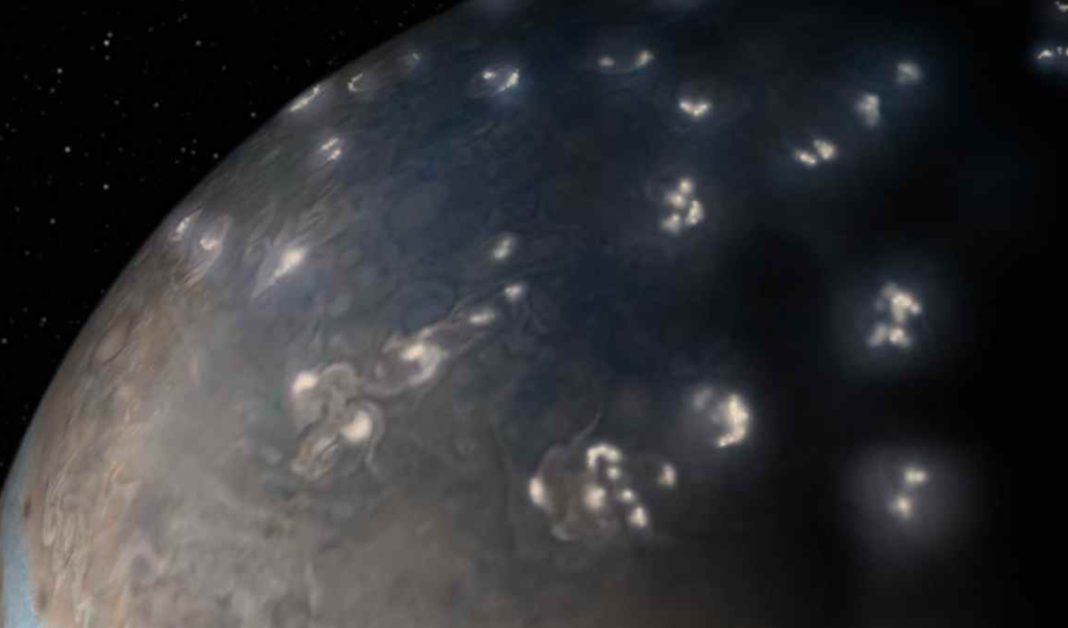UNITED STATES: In a groundbreaking discovery, NASA’s Juno spacecraft has provided unprecedented insights into the lightning processes occurring on Jupiter, revealing striking resemblances to those witnessed on Earth. Despite the vast differences between the two planets, Juno’s extensive collection of high-resolution data over five years has unveiled a surprising parallel in the initiation of lightning between the gas giant and our own planet.
Ivana Kolmasova, a planetary scientist at the Institute of Atmospheric Physics of the Czech Academy of Sciences in Prague, led a team of researchers who meticulously examined the wealth of data that Juno’s radio receiver collected while it orbited Jupiter. Their findings, published this week in the prestigious journal Nature Communications, highlight the rhythmic pulsations observed in Jupiter’s lightning initiation processes, akin to the pattern witnessed within terrestrial thunderclouds.
Lightning, nature’s most powerful electrical phenomenon on Earth, originates from electric discharges within thunderclouds. When ice and water particles within these clouds collide, they create layers of similarly charged particles, giving rise to a substantial electric field that triggers the awe-inspiring discharge. While the intricacies of this process are not yet fully understood, the simplified explanation sheds light on the fundamental similarities shared by Jupiter and Earth.
The existence of lightning on Jupiter was first confirmed in 1979 when NASA’s Voyager 1 spacecraft recorded distinctive radio emissions at audible frequencies during its epic journey through the solar system. This initial revelation paved the way for further exploration into the electrifying phenomena occurring within the atmospheres of other gas giants such as Saturn, Uranus, and Neptune.
Although lightning activity within the clouds of Venus remains a topic of debate, these recent findings on Jupiter strengthen the case for lightning occurrences on rocky planets as well.
Further comparisons between Jupiter and Earth have yielded intriguing insights. While the overall lightning rates are similar, the distribution of these powerful electrical discharges differs significantly. On Earth, tropical regions are the hotspots of lightning activity, whereas, on Jupiter, the majority of lightning occurs in mid-latitudes and polar regions. Interestingly, the researchers note a distinct lack of lightning activity near Earth’s poles, setting it apart from the gas giant.
Ivana Kolmasova explains, “Conditions for the formation of Jovian and terrestrial thunderclouds are probably very different. We have nearly no lightning activity close to the poles on Earth.” Kolmasova and her team are planning further analysis to explore the power of Jupiter’s lightning, with preliminary assessments indicating similarities to the most intense terrestrial lightning bolts.
Jupiter, a colossal gas giant primarily composed of hydrogen and helium, commands attention with its distinctive stripes and mesmerizing storms. With a diameter of approximately 88,850 miles (143,000 km), this fifth planet from the sun dominates our solar system. Since 2016, NASA’s Juno probe has been diligently orbiting Jupiter, meticulously studying its atmosphere, internal structure, magnetic field, and the magnetic environment surrounding the planet.
As Juno continues to unveil the secrets hidden within Jupiter’s tumultuous atmosphere, scientists are excited about the unexpected parallels discovered between the lightning processes on Jupiter and Earth.
This newfound understanding not only deepens our knowledge of the universe but also underscores the interconnectedness of natural phenomena across different celestial bodies. The mysteries of the cosmos continue to captivate and inspire, inviting us to explore further and unravel the enigmatic wonders that lie beyond our home planet.
Also Read: NASA’s Juno Spacecraft to Make Historic Close Flyby of Jupiter’s Volcanic Moon, Io



